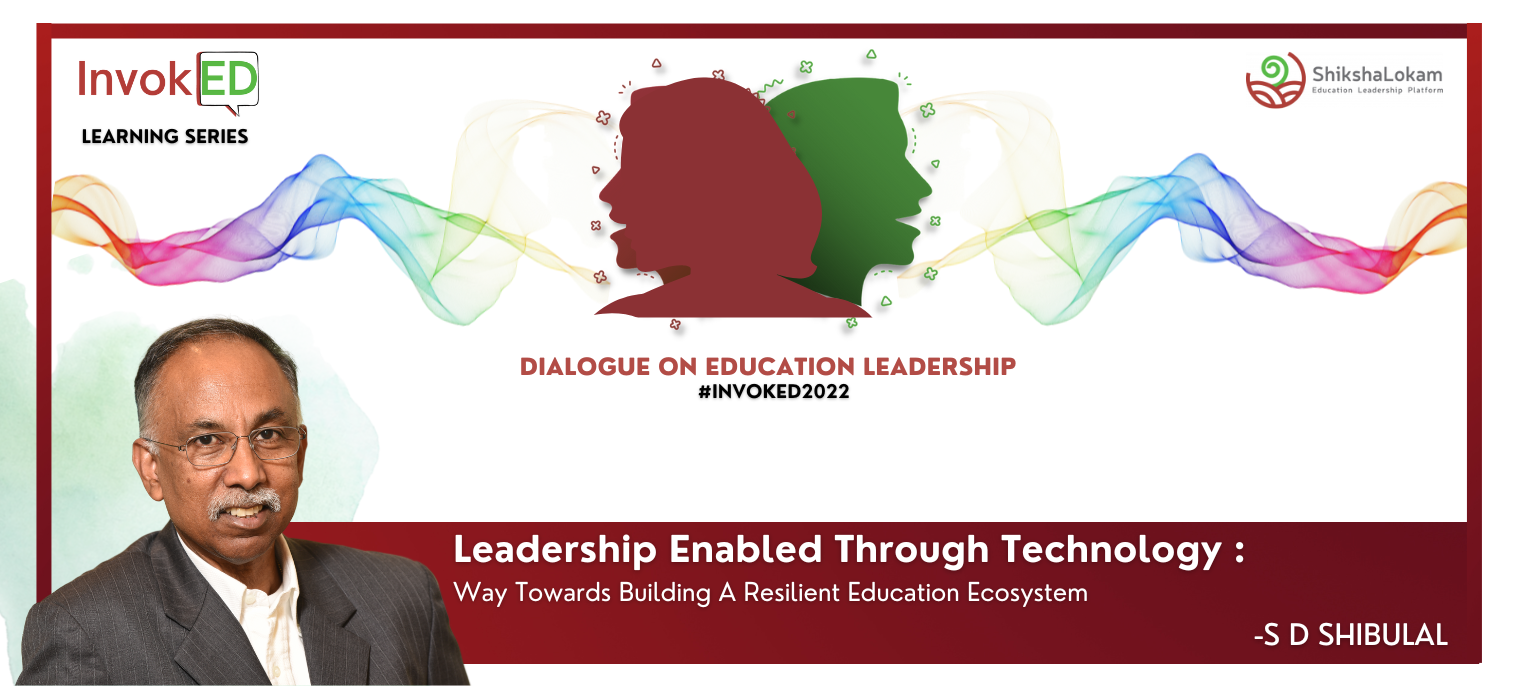
Leadership Enabled Through Technology :
Way Towards Building A Resilient Eduction Ecosystem
India is a land of contradictions. We produce a million engineers every year – at the same time, there are 16 to 20 million children who are not in school. 70% of our doctors are in urban areas, whereas 70% of our population is in rural areas. When I was 30 and just starting my career, India had 30 million people in the middle-class. Today that number is 10 to 15 times more, but we still have millions of people below the poverty line.
Despite the stark differences, we are also a uniquely amazing country. Recently, I was travelling to Kerala from Bangalore and I was able to work throughout the 14 hour period with complete connectivity from Bangalore to my small village in Kerala. We have 1 billion people using biometric ID Aadhaar – the largest biometric ID system in the world. Indians have 1.2 billion mobile phones, out of which 750 million are smart phones. We have been able to deliver 1.8 billion vaccines – close to 20% of the world’s total vaccines. In November 2021, I was abroad and people were still carrying paper certificates in their bags – whereas in India we can access the vaccine certificate immediately after the vaccination on our smartphones. These are just a few amazing success stories which I don’t see being duplicated anywhere else.
Teaching…Managing…
I was visiting a school in one of the clusters we work. It is less than 5 Kms away from a big multinational firm’s corporate office. The school had beautifully painted boundary wall and gates. From outside, it looked like a small house, but for the distinctive, colorful logo of the then Sarva Shiksha Abhiyaan (SSA).
It was a primary school with two classrooms and a small play area. In one classroom, 11 children were sitting on colorful mats on the floor in three circles. These were from grade 1 to 3. The teacher was helping the youngest group seated in the front circle with some reading exercises. The second classroom had 6 children who were in grade 4 and 5. They seemed to be copying something from the blackboard in their notebooks. Seeing me, the teacher came out to greet, and informed how the other teacher had to leave for a meeting in the block office. She had been managing both the classrooms alone since morning.
It was nearing lunchtime, and she sheepishly asked me if I could sit inside the Gr 1-3 classroom for some time, while she quickly checks the midday meal. I said yes. She looked relieved. She explained further, “These are very young children. If someone is not there to supervise, they may start running around, or even go outside the gate. Usually they listen, but there is always a risk.”
I asked, “How’d you have managed if I were not here?”
“Oh, I’d have asked Rajesh (one of Grade 5 students) to look after them. We have to manage somehow.”, she said with a smile.
While I was sitting in the classroom listening to children’s happy voices, I couldn’t help, but wonder if this is the best use of the teacher or the students’ time in a school setting.
The contradictions are replete in our education ecosystem as well. The growth in the gross enrolment ratio is enormous – for upper primary it is 89% and 51% in higher secondary. However, many reports such as the ASER, point out that a 5th Grader cannot even read a 2nd Grade textbook, that the maths skills of a 7th Grader is the same as that of a 2nd grader. Employability studies published by many of the global consulting organisations claim that only 25% graduates are employment ready. While we have increased access to education for our children, the quality of education deserves a lot more attention now.
DID YOU KNOW?
- 60% of all public schools under the Department of Education are Primary Schools, i.e Grade 1-5; i.e. 3 out of every 5 public schools are from Gr 1-5.
- 1 out of every 5 of these primary schools (Gr 1-5) has a single teacher. Typically, others have 2 or 3 teachers per school.
- Average number of students in these primary schools is 32 in urban regions and 43 in rural areas. So per class, these have less than 10 students. Typically, 30-40 students is the size of each section of a class in any private CBSE school.
On the bright side, there is already a lot of impetus being given towards improving teacher-student interactions in order to improve the quality of education. But another key influencer who ensures the creation of a conducive learning environment is being overlooked and is unrecognised – the school leader.
Recognising the Deficit of Leadership in Education
A school leader is someone who creates an ideal school environment that enables teachers, students and community to work together in-tandem to support learning. We must acknowledge that the education ecosystem faces a shortage of people and skills, at all levels. According to a 2021 report by UNESCO, India has a shortage of over one million teachers in schools. Our field experiences reveal an even more acute shortage of qualified head teachers and principals who can lead a school. We have about 250 million children in 1.5 million schools that need to be led and managed by effective school leaders. There is a lack of understanding of responsibilities amongst the leaders who are helming the roles. There is a clear gap of knowledge, skills and mindsets that are needed to run schools effectively. There needs to be greater commitment to work together towards improving the capacity and quality of our schools.
Building a Solution for Education System
There are two factors at play, when we look at some of our experiences and success stories.
- Leadership Across Levels – The country has made huge strides across domains – business, technology, defence, public administration, CSR, etc. It is evident that there is not just one person or one department which is leading the change. For instance, when one looks closely at the vaccination story, there was not a centralised organisation handling 1.8 billion vaccines by itself. It has been made possible because of leadership at every level – panchayat, district, state. This is true across domains and geographies.
- Use of Technology for Public Good – Every one of these success stories – whether it is Aadhaar [for identification and distribution of benefits by the government], whether it is Aarogya Setu [to access vaccination certificates + contact tracing and self assessment], whether it is DIKSHA [for education stakeholders to learn and improve] – each of them is a technological miracle. All of these are examples of a targeted use of technology to contribute towards public good. Also, these are fundamental building blocks that serve as Digital Public Goods and open pathways for the ecosystem to newer value creation.
With the combination of developing leadership and using digital technology, we can create systems which are scalable and extremely resilient. These hold the potential to create an impact across the country.
Samaaj, Sarkar, Bazaar Together
Excellent school principals will be able to support the teachers, work with them to engage parents, and build an effective learning environment in schools. Visionary bureaucrats and politicians will be able to create an environment that enables the principals and teachers to thrive and also build the urgency needed to create the leadership development programs. Active civil society organisations will contribute to developing and nurturing school leadership and will energise the community-facing actors to increase participation in school development. Committed market leaders who believe in the cause of leadership development will mobilise the necessary resources to support the school system. We need people and leadership at all levels – we need the intersection of this trinity to make schools better and good-quality student learning sustain.
There is an urgency to recognise, acknowledge and appreciate what the leaders in education are doing on an everyday basis and the impact it has on the student outcomes. Leadership can be developed, provided there are avenues for learning and application. For a country like ours – full of contradictions – to achieve its full potential, it is important to strive towards a self-healing, self-improving resilient education system that can take care of its own challenges. It should be innovating constantly, rather than being dependent on any external forces or stimulus to make that change.
This piece is first in the InvokED learning series and has been extracted from the conversations at the global dialogue. You also can listen to this address here.
Meet the Author

Luv Kumar
Having fallen in love with stories in his childhood, Luv makes his living as a storyteller. He strongly believes in the power of stories to make this world a better place. Luv currently manages communications at ShikshaLokam to drive collective action for enabling education leadership. He is a Teach for India Alum and has also worked with non profit education startups & media agencies in the past.

Luv Kumar
Having fallen in love with stories in his childhood, Luv makes his living as a storyteller. He strongly believes in the power of stories to make this world a better place. Luv currently manages communications at ShikshaLokam to drive collective action for enabling education leadership. He is a Teach for India Alum and has also worked with non profit education startups & media agencies in the past
